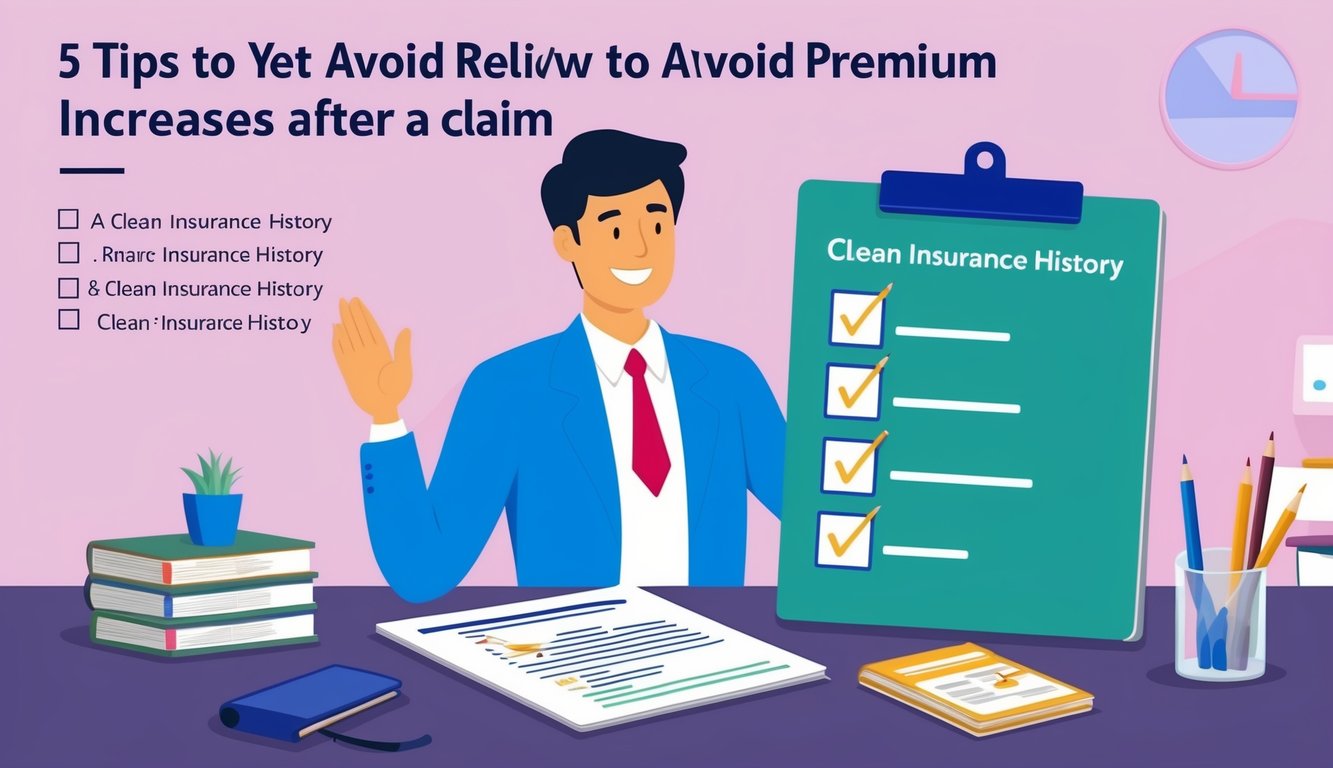Filing an insurance claim can be stressful, especially when you’re worried about potential premium increases.
Many drivers find themselves facing higher rates after making a claim, even for accidents that weren’t their fault.
This situation can leave you feeling frustrated and uncertain about your financial future.
You can take proactive steps to minimize or avoid insurance premium hikes after filing a claim. By understanding how insurers calculate risk and implementing smart strategies, you may be able to maintain your current rates or even find better deals elsewhere.
This article will explore five practical tips to help protect your wallet and maintain affordable coverage after an accident or claim.
1) File claims promptly and accurately
When you experience an incident that requires an insurance claim, acting quickly is crucial.
Timely filing helps ensure all details are fresh in your mind and evidence is readily available.
Contact your insurance provider as soon as possible after the event.
Many policies have specific timeframes for reporting claims, and delays could jeopardize your coverage.
Gather all necessary documentation before filing.
This includes photos, police reports, medical records, and any other relevant information. Documentation is the backbone of any insurance claim.
Be thorough and honest when describing the incident to your insurer.
Provide clear, factual information without omitting important details.
Accuracy helps prevent misunderstandings or potential accusations of fraud.
Keep detailed records of all communication with your insurance company.
Note dates, times, and names of representatives you speak with.
This can be valuable if any disputes arise later.
Follow up regularly on the status of your claim.
Prompt responses to any requests for additional information can help expedite the process.
By filing claims promptly and accurately, you demonstrate responsibility to your insurer.
This can potentially mitigate premium increases, as insurers may view you as a lower risk client.
2) Document all damages thoroughly

When filing an insurance claim, thorough documentation is crucial to avoid premium increases.
Start by taking comprehensive photos and videos of all damages immediately after the incident.
Capture wide-angle shots of entire rooms or areas to provide context.
Then, take detailed close-ups of specific damages to highlight their extent and severity.
If possible, include before-and-after comparisons to show the contrast.
This helps insurers understand the full scope of the damage.
Create a detailed inventory of damaged items.
Include descriptions, estimated values, and purchase dates if available.
Keep receipts for any emergency repairs or temporary accommodations.
Document all communication with your insurance company.
Keep a log of phone calls, emails, and in-person meetings, including dates, times, and names of representatives you speak with.
Obtain written estimates from licensed contractors for necessary repairs.
Multiple estimates can strengthen your claim and demonstrate you’re seeking fair compensation.
Maintain a file with all claim-related documents, including your policy, correspondence, and repair estimates.
This organized approach can expedite the claims process and help prevent disputes.
By thoroughly documenting damages, you provide clear evidence to support your claim.
This reduces the likelihood of claim denials or undervaluations, which could lead to premium increases.
3) Keep a clean driving record
Maintaining a spotless driving record is crucial for avoiding insurance premium hikes.
Focus on safe driving habits every time you get behind the wheel.
Always obey traffic laws and speed limits.
Speeding tickets and other moving violations can quickly lead to increased premiums.
Avoid distractions while driving.
Put your phone away and keep your hands on the wheel and eyes on the road.
Practice defensive driving techniques.
Anticipate potential hazards and leave plenty of space between your vehicle and others.
Never drive under the influence of alcohol or drugs.
DUIs have severe consequences for both your safety and insurance rates.
Take a defensive driving course to improve your skills and potentially qualify for insurance discounts.
Regularly maintain your vehicle to prevent accidents caused by mechanical issues.
Keep up with oil changes, tire rotations, and brake inspections.
Be extra cautious in adverse weather conditions.
Slow down and increase following distances when driving in rain, snow, or fog.
If you do receive a ticket, consider traffic school to keep it off your record.
Many states offer this option for minor violations.
By consistently practicing safe driving habits, you can maintain a clean record and avoid costly insurance premium increases.
4) Utilize accident forgiveness programs
Accident forgiveness is a valuable feature offered by many insurance companies.
This program can help you avoid premium increases after your first at-fault accident.
To take advantage of accident forgiveness, check if your current policy includes this benefit.
Some insurers automatically provide it to long-term customers with clean driving records.
If your policy doesn’t include accident forgiveness, consider adding it as an optional coverage.
While it may increase your premium slightly, it can protect you from significant rate hikes if you have an accident.
Keep in mind that accident forgiveness typically applies only to your first at-fault accident.
It’s a one-time benefit, so use it wisely.
Different insurers have varying terms for their accident forgiveness programs.
Some may require you to maintain a clean driving record for a certain period before qualifying.
Geico’s accident forgiveness, for example, can prevent premium increases ranging from 2% to 50%, depending on your circumstances.
Remember that accident forgiveness doesn’t erase the accident from your record.
It simply prevents your insurer from raising your rates due to that specific incident.
By utilizing accident forgiveness, you can gain peace of mind knowing that a single mistake won’t lead to a drastic increase in your insurance costs.
5) Bundle your insurance policies
Bundling your insurance policies can be an effective way to reduce your overall premiums.
This strategy involves combining multiple insurance products with the same provider.
Common bundles include auto and home insurance, or auto and renters insurance.
By bundling your policies, you can often unlock significant discounts.
Many insurers offer multi-policy discounts as an incentive for customers to consolidate their coverage.
These discounts can range from 5% to 25% off your premiums, depending on the provider and policies bundled.
Bundling also simplifies your insurance management.
You’ll have fewer bills to track and a single point of contact for multiple coverage types.
When considering bundling, compare quotes from different providers.
Sometimes, separate policies from different companies might still be cheaper than a bundle.
Remember that bundling isn’t always the best option for everyone.
Evaluate your specific needs and compare total costs before making a decision.
If you’ve recently filed a claim, bundling your policies could help offset potential premium increases.
It’s a proactive step to manage your insurance costs.
Understanding Insurance Premiums

Insurance premiums are the regular payments you make to maintain your coverage.
They reflect the financial risk you pose to the insurance company based on various factors.
What Influences Premium Rates?
Your age, location, and claims history significantly impact your insurance premiums.
Younger drivers often face higher rates due to their perceived inexperience.
Your zip code matters too, as areas with high crime or accident rates typically lead to increased premiums.
The type of vehicle you drive affects your rates.
Expensive cars or those with high theft rates usually cost more to insure.
Your credit score can also play a role, with better scores often resulting in lower premiums.
Coverage levels and deductibles influence your rates. Higher coverage limits and lower deductibles generally mean higher premiums.
Conversely, raising your deductible can lower your monthly payments.
How Claims Affect Premiums
Filing a claim can lead to premium increases, especially if you’re at fault.
Insurance companies view claims as indicators of future risk.
The severity and frequency of claims impact how much your rates might rise.
Some insurers offer accident forgiveness, which can prevent rate hikes after your first at-fault accident.
However, this benefit often comes at an additional cost.
Multiple claims within a short period can result in substantial premium increases or even policy non-renewal.
It’s important to weigh the cost of potential premium increases against the claim payout when deciding whether to file a claim.
Remember, most claims stay on your record for about five years, affecting your rates during that time.
Effective Communication with Your Insurer

Clear and precise communication with your insurance provider is crucial after filing a claim.
By providing accurate information and negotiating effectively, you can potentially minimize premium increases and ensure a smoother claims process.
Reporting a Claim Accurately
When reporting a claim, be honest and thorough. Provide accurate and timely information about the incident to your insurer.
Stick to the facts and avoid speculating about fault or damages.
If you’re unsure about certain details, it’s okay to say so.
Create a paper trail by following up phone conversations with an email summarizing the key points discussed.
This helps prevent misunderstandings and provides a record of your communications.
Take detailed notes during conversations with your insurer, including:
- Date and time of the call
- Name of the representative you spoke with
- Claim number (if assigned)
- Summary of what was discussed
Negotiating with Your Insurance Provider
When you negotiate with your insurer, be prepared and professional.
Familiarize yourself with your policy terms and coverage limits before discussions.
This knowledge will help you understand your rights and options.
Ask questions if anything is unclear.
Don’t be afraid to request clarification on policy details or claim decisions.
Keep a list of questions ready before each interaction.
If you disagree with a decision, calmly explain your position and provide supporting evidence.
Be open to compromise but also advocate for your interests.
Consider taking a qualifying driving class to demonstrate your commitment to safe driving.
This may help reduce potential premium increases after a claim.
Maintaining a Good Insurance History

A clean insurance record and responsible behavior can significantly impact your premiums.
These factors demonstrate your reliability to insurers and can lead to substantial savings over time.
Importance of a Clean Record
Maintaining a clean driving record is crucial for keeping your insurance rates low.
Avoid traffic violations and accidents to prevent strikes on your record.
If you do get into an accident, consider paying for minor damages out-of-pocket instead of filing a claim.
Take defensive driving courses to improve your skills and potentially earn discounts.
Some insurers offer up to 10% off for completing approved courses.
Report any changes in your driving habits to your insurer.
If you’re driving less, you might qualify for lower rates.
Long-Term Benefits of Responsible Behavior
Consistently responsible behavior can lead to significant long-term benefits.
Many insurance companies offer good driver discounts of up to 30% for maintaining a clean record over time.
Consider opting for usage-based insurance programs.
These programs track your driving habits and can reward safe driving with lower premiums.
Build a positive relationship with your insurer by paying bills on time.
Also, communicate openly about any changes in your situation.
Regularly review your policy to ensure you’re not overpaying for coverage you don’t need.
As your car ages, you might be able to drop comprehensive or collision coverage.






